Define area paths and assign to a team
Azure DevOps Services | Azure DevOps Server 2022 - Azure DevOps Server 2019
Add area paths to organize teams and group work items by product, feature, or business areas. Assigning area paths to teams ensures that work items under those paths appear on the respective team's backlogs and boards. By default, all work items are assigned to the root area path and appear in the project's default team.
After you define area paths at the project level, assign them to teams within the team configuration. You can also create a hierarchical structure of area paths to support subareas, with up to 14 levels deep.
To perform the following tasks, you must define area paths:
- Query and chart work items based on Area Path
- Assign work to more than one team
- Work with management and feature teams
- Filter a backlog, query, board, or plan using Area Paths
Tip
You can define your area path structure and assign area paths to teams. Or, you can add a team and create the area path with the team name at that time. If teams are fully independent, create a flat set of area paths. However, if you want to create a hierarchy of teams, then you'll want to create a tree-hierarchy of area paths. For more information, see Configure a hierarchy of teams.
To use the following tools, teams must subscribe to area paths:
To understand how the system uses area paths, see About area and iteration paths.
Prerequisites
| Category | Requirements |
|---|---|
| Permissions | - To set team area or iteration paths: Team administrator or a member of the Project Administrators group. By default, the user who created the project has these permissions. - To add an area path under the root node or edit or delete any child node: Member of the Project Administrators group. - To add, edit, and manage area paths under a node: One or more of the following permissions set to Allow: - Create child nodes - Delete this node - Edit this node - View permissions in this node |
For more information, see Set permissions and access for work tracking.
For naming restrictions on area paths, see About areas and iterations, Naming restrictions.
Get started
Each team has access to various Agile tools, as described in About teams and Agile tools. These tools reference the team's default area paths. Most teams use one area path and several iteration paths for work tracking, but teams can also use multiple area paths on their backlogs and boards to support different scenarios.
New projects include a single root area corresponding to the project name and a default team with the same name assigned to this root area path.
If you're new to managing projects and teams, follow these steps to configure your project and teams:
- Define area paths: Determine the number and names of area paths needed to categorize your work. Add at least one area path per team. For more information, see About areas and iterations.
- Define teams: Decide the number and names of teams required. For more information, see About teams and Agile tools.
- Configure area paths: Go to Project settings > Project configuration > Areas and define the area paths for your project. Follow the steps in Add area paths.
- Create teams: Create the necessary teams based on step 2. For more information, see Add a team, move from one default team to several teams.
- Assign area paths to teams: In the team configuration, assign the default and other area paths to each team. Do the steps in Set team default area paths.
- Assign area paths to work items: Assign work items to the defined area paths using bulk modify to update multiple items at once.
Note
Assigning the same area path to multiple teams may cause conflicts over work item ownership. For more information, see Limitations of multi-team board views.
As needed, you can do the following actions at any time:
- Add other child nodes
- Rename an area path (except the root area path)
- Move a child node under another node
- Delete a child node
- Rename a team
- Change the area path assignments made to a team
List project areas
To list project areas, do the following steps:
From your web portal, select (1) Project settings > (2) Project configuration > (3) Areas.
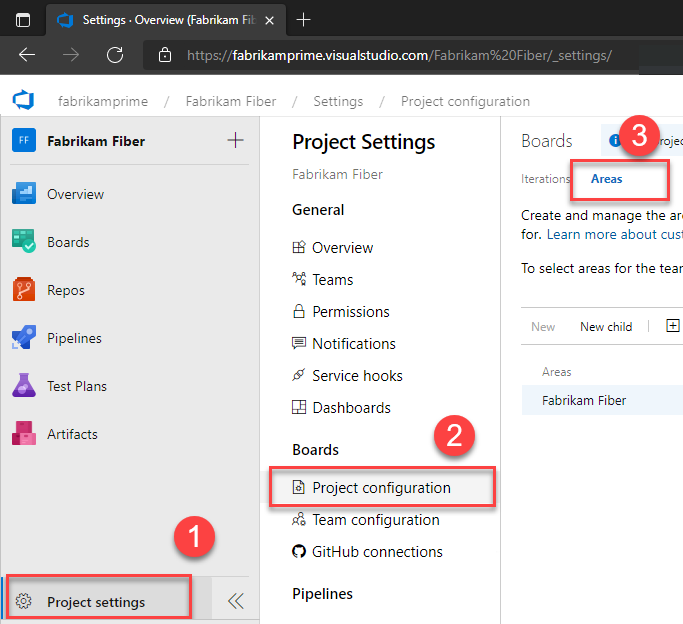
Add an area path
Only one root area is defined by default. Add new and child area paths under the root area path for the project, or as a child to another area path or team. New area paths are added to the root node by default.
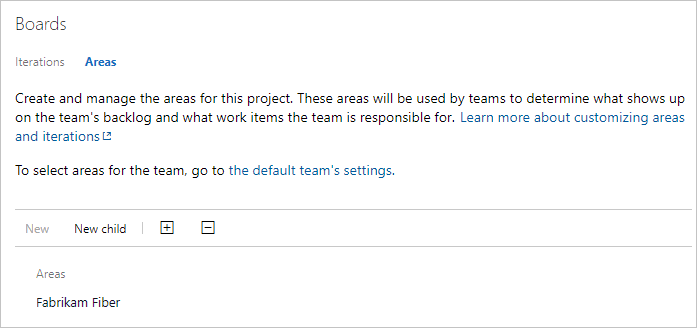
You can also add new and child area paths to a team. For more information, see Set team area paths.
To add a new area path, do the following steps:
Highlight the area path and then choose New child. Optionally, you can select
 for an area path and choose New, or select the New menu item at the top of the area list.
for an area path and choose New, or select the New menu item at the top of the area list.Enter a name (255 characters or less) for the node. For more name restrictions, see About areas and iterations, Naming restrictions.
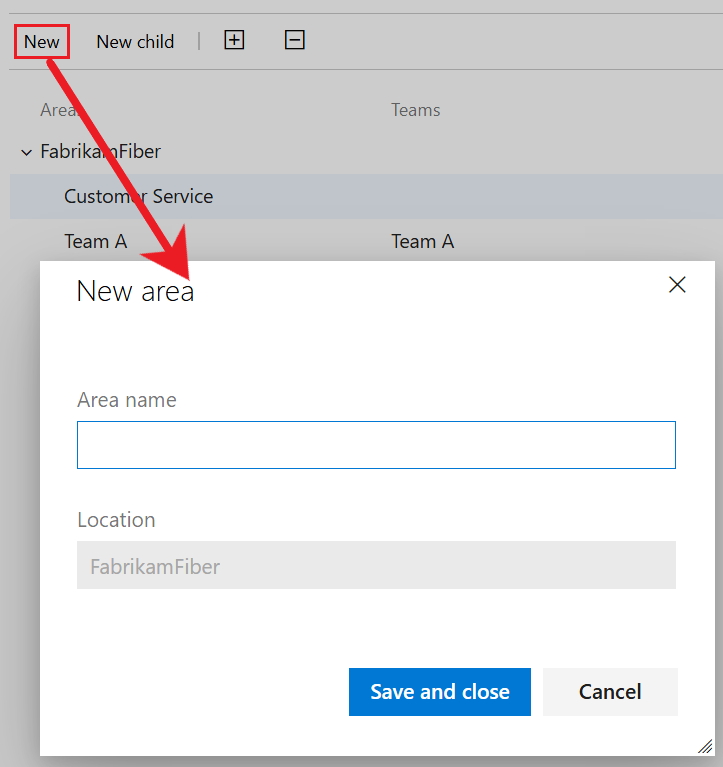
Select Save and close
All new areas are added as a child node to the root area path.
To add a child area path, do the following steps:
Highlight the area path and then choose New child. Optionally, you can select
 for the area path and choose New child or select New child from the menu at the top of the area list.
for the area path and choose New child or select New child from the menu at the top of the area list.Enter a name (255 characters or less) for the node. For more name restrictions, see About areas and iterations, Naming restrictions.
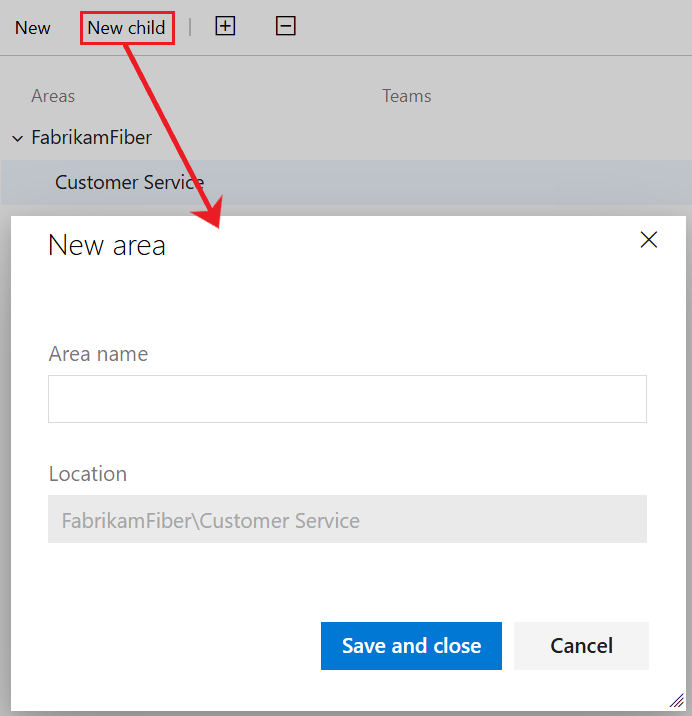
Select Save and close
You can also add area paths to a team on the Team configuration > Areas page.
List team area paths
You set team defaults from team settings. If you're not a team administrator, get added as one. Only team or project administrators can change team settings.
Open your project, and then select Project settings > Team configuration > Areas.
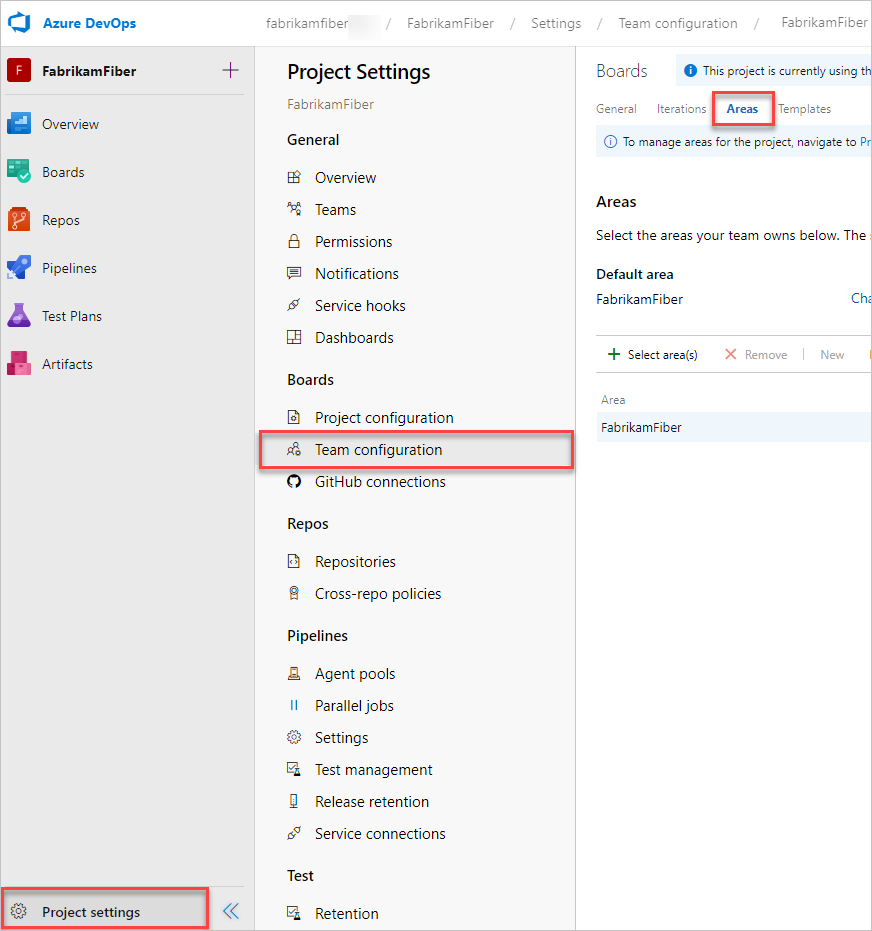
If you need to switch the team context, use the team selector within the breadcrumbs.

Open team settings from the team profile
You define both areas and iterations from Project Settings > Team configuration. You can quickly navigate to it from a team work tracking backlog, board, or dashboard.
Open a backlog or board for a team and choose Team profile
 > Team Settings.
> Team Settings.Here we open the Board for the Fabrikam Fiber team and from there the team profile.

Choose Iterations and areas.
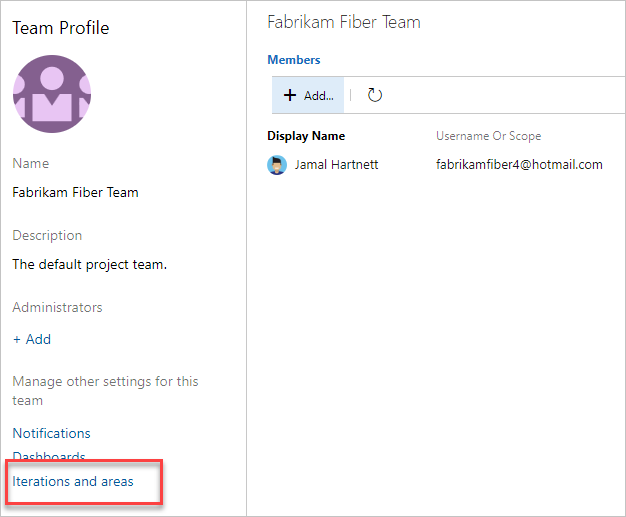
If you need to switch the team context, use the team selector within the breadcrumbs.
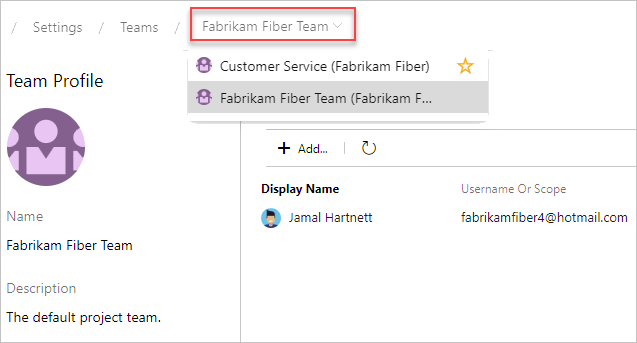
Set team area paths
All work items that are assigned to a team area path appear on the backlogs and boards for that team. You can select one or more area paths and optionally include their subarea paths. Choose to include subarea paths when you want to support rollup views of work done across several teams or areas.
Note
Teams can be assigned a maximum of 300 Area Paths. For more information, see Work tracking, process, and project limits.
The default area path determines the default area path assigned to work items that are created from the team context.
Important
Work items that appear on more than one team's board can yield query results that don't meet your expectations. Because each team can customize the board columns and swimlanes, the values assigned to work items which appear on different boards may not be the same. The primary work around for this issue is to maintain single ownership of work items by team area path.
You can select existing area paths or create new or child area paths from the team settings.
Select Project settings > Team configuration > Areas.
Select the team you want to configure from the drop-down list at the top of the page.
Here, we show the Areas for the Fabrikam Fiber team.
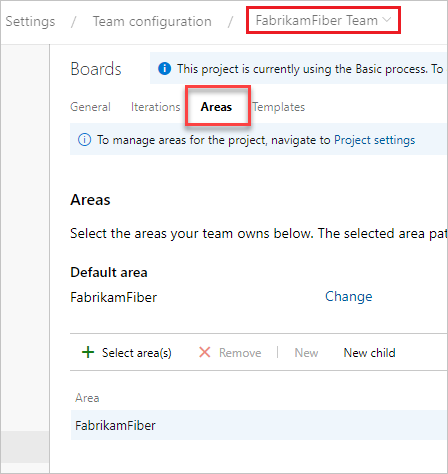
Choose one or more area paths to be active for the team.
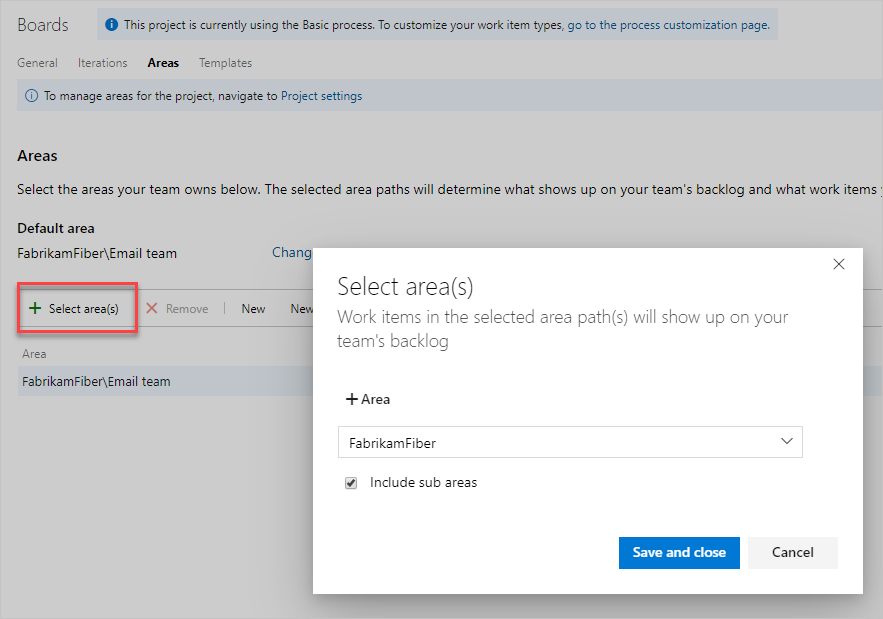
In this instance, we choose to activate the subarea paths for the project. The management team can now track progress across all teams.

When you finish, refresh the product backlog page for the team, and you see those work items assigned to the team. Add area path to the columns shown to see the assignments made to work items.

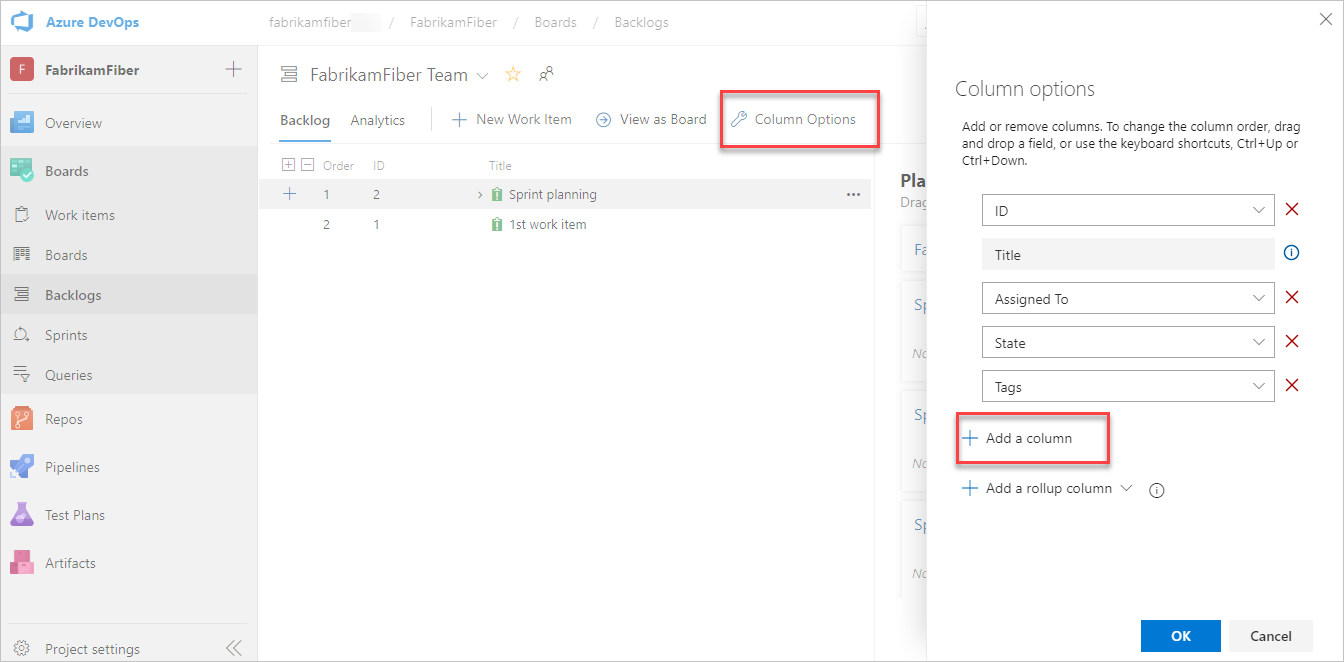
Open Areas for the team context.
Here, we show the Areas for the Fabrikam Fiber team.
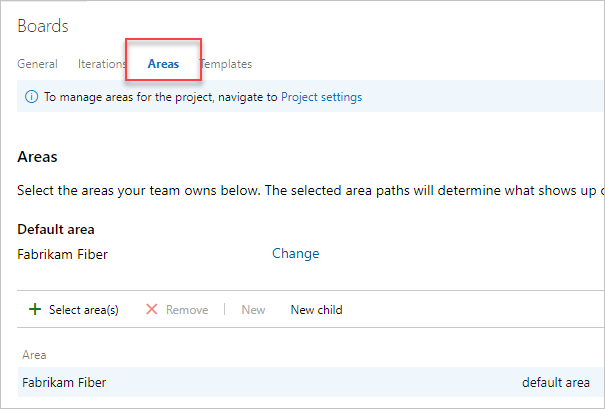
Choose one or more area paths to be active for each team.
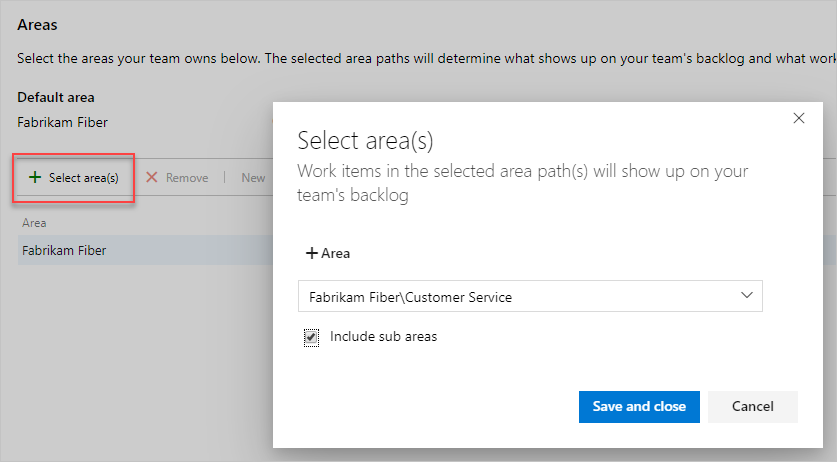
In this instance, we choose to activate all three subarea paths for the project. The management team can now track progress across all three teams.

When you finish, refresh the product backlog page for the team, and you see those work items assigned to the team. Add area path to the columns shown to see the assignments made to work items.

Rename or move an Area Path
The system automatically updates work items and queries that reference your updated area path. Each Area Path is associated with a unique GUID.
To rename an Area Path, open the web portal Project settings>Project configuration>Areas page.
Choose the
 context menu for the node, and select Edit.
context menu for the node, and select Edit.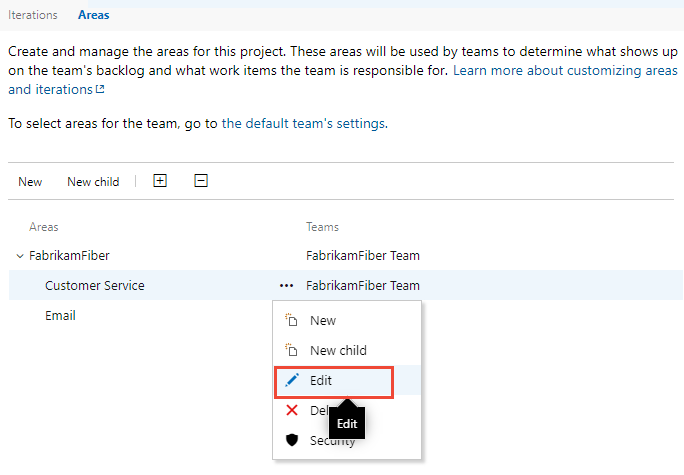
In the dialog that opens, enter the new name.
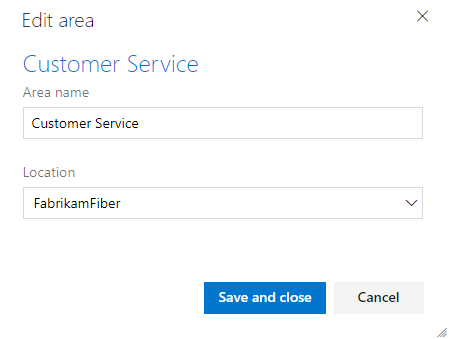
To move the node within the hierarchy, change the Location field.
Note
When you rename or change the Location field for a node, the system automatically updates the existing work items that reference the Area Path.
Delete an Area Path
When you delete an Area Path, you must provide an Area Path to use to update the work items assigned to the Area Path you want to delete.
Important
- Deleting Area Paths or reconfiguring Iteration Paths causes irreversible data loss. For example, burndown and burnup widget charts, sprint burndown, and velocity charts for teams with changed Area Paths won't display accurate data. Historical trend charts reference the Area Path and Iteration Path as they were defined at the time for each work item. Once deleted, you can't retrieve historical data for these paths.
- You can only delete area and iteration paths that are no longer used by any work items.
To delete an Area Path, open the web portal Project settings>Project configuration>Areas page.
Choose the
 context menu for the node, and select Delete or Remove.
context menu for the node, and select Delete or Remove.In the dialog that opens, select the Area Path to reassign work items to, and then choose Delete path.
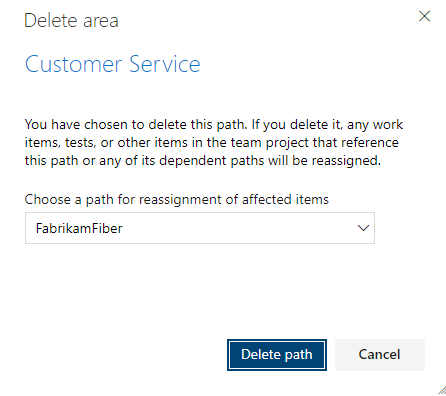
Chart progress by area
You can quickly generate queries to view the progress based on an area path. For example, visualize progress of work items that are assigned to each team's area path, as shown in the following stacked bar chart. Choose Node Name to get the leaf node of the area path.
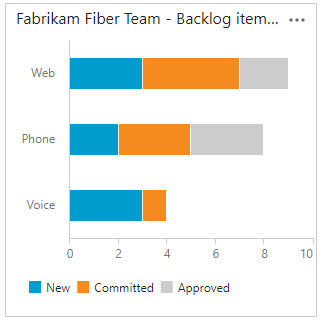
Next steps
Related articles
As you can see, area paths play a major role in supporting Agile tools, teams, and managing work items. Learn more about working with these fields from the following articles:
- Learn about areas and iterations
- Add another team
- Configure team settings and add team administrators
- Use Agile tools that rely on areas or iterations
- Query by area or iteration path
- Set permissions and access for work tracking
Programmatic resources
Area paths and iteration paths are also referred to as Classification Nodes.
- Use the az boards area (Azure DevOps CLI).
- Use the Teams (REST API) to manage team configurations.
- Utilize the Classification Nodes (REST API) to organize work item classifications.
- Use the Teams (REST API) to manage team configurations.
- Utilize the Classification Nodes (REST API) to organize work item classifications.
- Configure the process by defining the classification plug-in (Process Template).